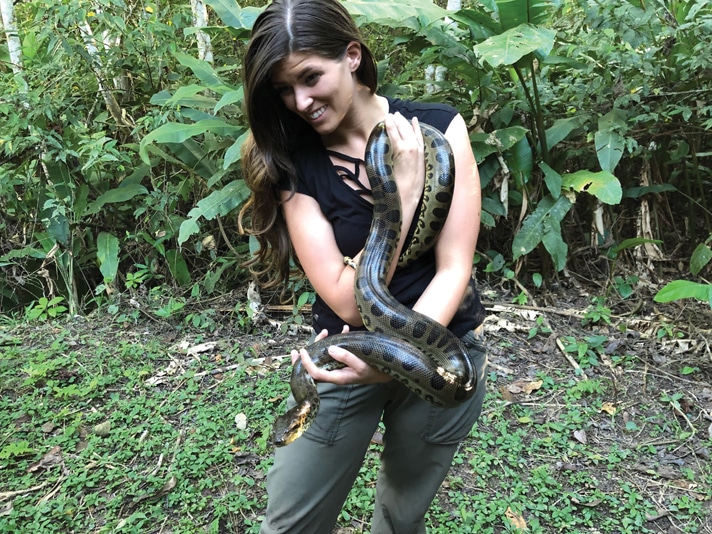Spending 8 days in the rainforest yields a variety of herptiles.
For a field herper, the Peruvian Amazon rainforest is a paradise beyond imagination. Look up, and you’ll always see something moving in the canopy: the almost-blinding iridescence that can only be a rainbow boa, or maybe the familiar markings of the boa constrictor climbing through the jungle, the brilliance of their red tail the only thing that stands out against the twisted tree trunks they disappear into. Shine your headlamp at night and you’ll see the eyeshine of frogs on every limb. Or, if you’re near the water, you won’t miss the unmistakable red twinkle of smiling caiman eyes, their toothy, sinister grin inviting you to just try and catch one.
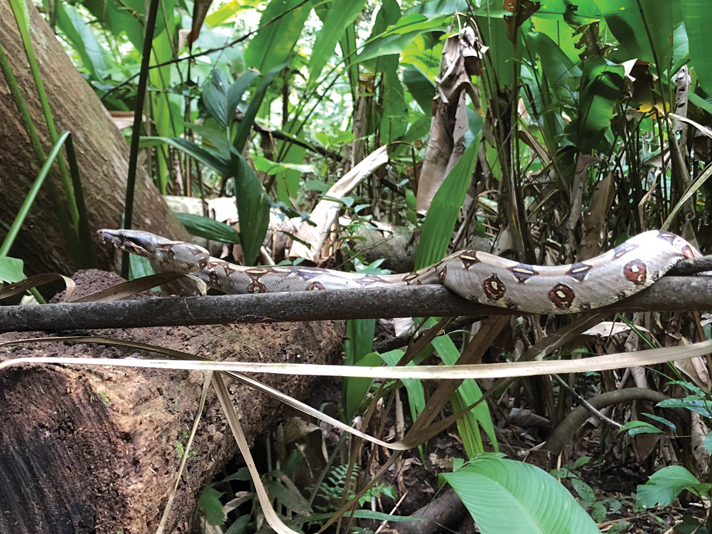
Amanda Sargent
Boa constrictors were plentiful under the forest canopy.
Traipsing Through the Rainforest
Meanwhile, swamping in the middle of the night, even for this herper, felt an awful lot like something out of a horror movie as I scanned the swampy path ahead for bushmasters, electric eels, and anacondas, of course. That’s why I was there, after all. This was no resort stay or guided tour—it was the adventure I’d always dreamed of, field herping to the extreme. Each time something brushed against my leg or crawled across my back in the dark of the jungle, I couldn’t let myself overthink it. I had to keep focused on the path ahead, reminding myself why I was out there, doing something I doubt many people would ever sign up to do.
For most people, being in a swamp up to your knees (and sometimes your neck, if you happened to walk into a particularly deep spot) at midnight in the middle of the wild Peruvian Amazon rainforest sounds like a nightmare. In many ways it was. Crossing black water filled with piranha on a fallen, rotting palm was a challenge. The constant cold showers and jungle sickness—and of course, I can’t forget to mention the bullet ant that fell straight onto my head from the jungle canopy while riding in the back of a rickshaw. I’ll never forget the fear of being instructed to stay perfectly still, while my expedition crewmates literally jumped out of the back of the vehicle to get away from me while the guides tried to determine the best way to remove the massive, venomous ant before it inflicted on me what is considered the worst sting of any insect in the animal kingdom. Somehow, I managed to walk away from that encounter unscathed.

Amanda Sargent
A beautiful rainbow boa.
As scary as it was, there was something about coming face-to-face with so many wild and exotic animals that made the adventure and the herps that I encountered so much better. As soon as I got home from my three-and-a-half-weeks in Peru, I was already thinking about when I could get back to that swamp again. Actually, I’d hesitate to call it a swamp.
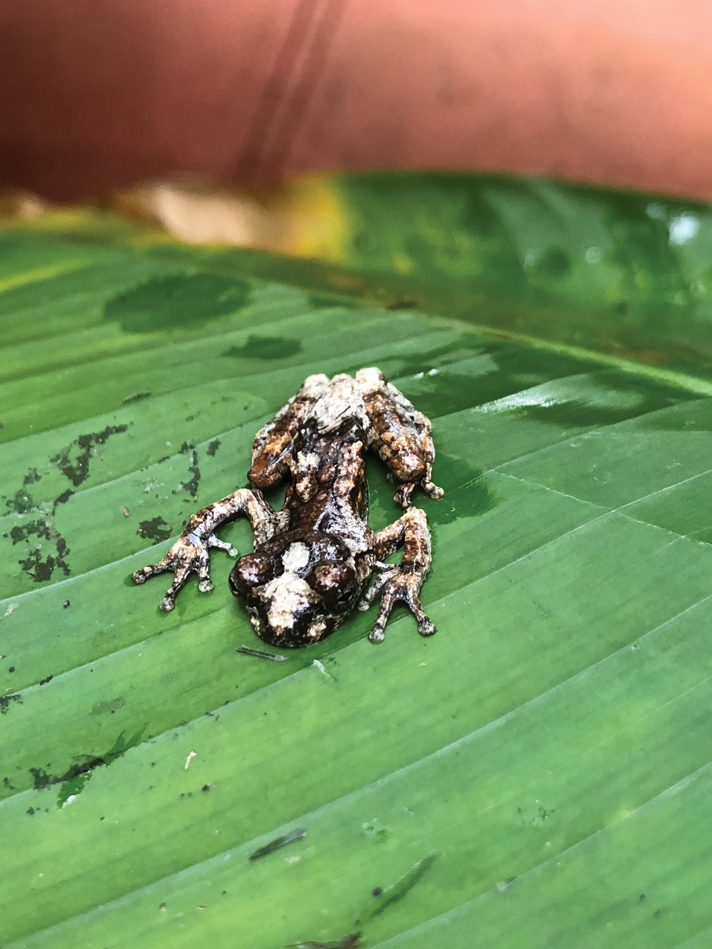
Amanda sargent
Dendropsophus marmaratus or marbled tree frog.
The place I spent the most time exploring, the Madre de Dios region of Peru, is unlike anything I’d ever seen or heard of. Locals call it the Floating Forest. You’d never find it by accident, and you’d never guess that clambering down through mud and thorns into a secret rainforest valley would reveal such a place. Swathes of grass float over rich, dark water, where caiman, tegus, tapirs, and electric eels coexist under the shade of half-submerged palms, while a rainbow of macaws call overhead. It’s beautiful, but it’s also brutal, and definitely not a tourist attraction. It takes guts and at least some degree of physical fitness to fight through the twisted swamp, but the reward is well worth the effort.
Golden tegus (Tupinambis teguixin) seemed to be positioned on every fallen branch, and we would lose count of the caiman we found. Caiman crocodilus, Paleosuchus trigonatus and Paleosuchus palpebrosus are plentiful in this region, along with the mighty Melanosuchus niger—you’ll know when you see one, and it’s best to observe these massive Amazonian predators from afar.
Looking for Green Anacondas
Just as it is any field herper’s dream, it had always been mine to not just visit, but to get hopelessly lost in the Amazon rainforest. When I was invited to participate on an expedition searching for green anacondas (Eunectes murinus), of course I jumped at the opportunity. Looking for anacondas in the Amazon is a surefire way to become completely immersed, as I quickly learned.
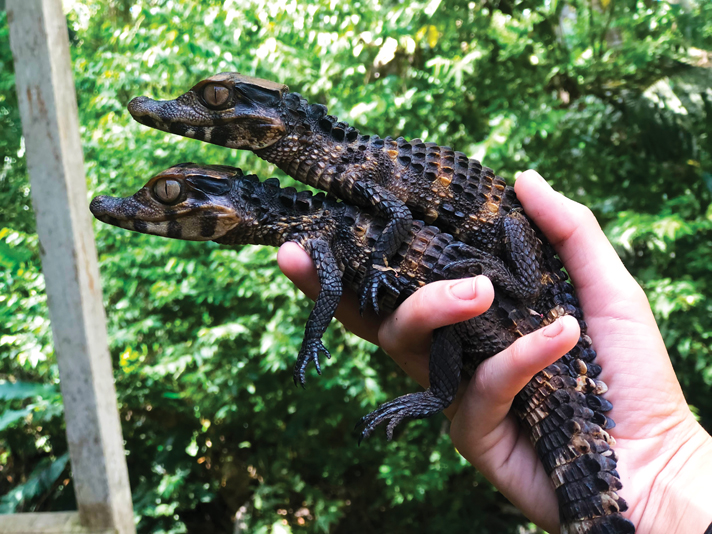
amanda sargent
Caiman were so plentiful we lost count how many were observed. Here are a pair of juveniles.
We spent six hours a day fighting through the thick, deep swamp, being bitten and stung and scratched, on top of cutting through the tangled growth, gripping the machete so hard our hands were raw. The tegus and caiman were great consolation prizes, but after a few hours of this, all I wanted to see were the spots of the anaconda.
And then, just as I’d start to wonder if they’re even here at all, we’d see the soft imprint of a snake in the grass: anaconda tracks. As we worked through their labyrinth I couldn’t help but feel their presence in everything; the habitat is just perfect, and there is prey everywhere: Aguti and caiman and capybara, even tapir for the real big snakes. We started to find massive sheds after the third day of searching, and by then, I knew they must’ve been watching us. It didn’t take any of us long to realize that no matter how hard we looked, we just weren’t in control. Not here. After eight long days and nights searching, we hadn’t found a single anaconda in the Floating Forest.
Although the green anaconda is arguably the most iconic snake on Earth, you might be surprised to find that virtually no research has been done on them for conservation purposes. They have not been assessed by the International Union for the Conservation of Nature, or IUCN, and are currently listed as Data Deficient. We know that anacondas have been easier to find in the past, and that locals, driven by fear passed down over generations, kill them every chance they get. We also know that their habitat is being destroyed at an alarming rate, displacing them and their important prey sources. Since they are vital players in one of the most dynamic and biodiverse places on Earth, it’s important we know their status in the wild, and right now, we’re acting on borrowed time.
Why hasn’t this research been done yet? Well, as I learned after spending almost two weeks looking for them, anacondas are not easy to find. For one thing, they spend most of their time deep in the almost-inaccessible swamps of the Amazon—places like the Floating Forest, where no sane person would willingly go, their coloration making them practically invisible against the murky water and vegetation.

amanda sargent
A lot of time was spent “swamping” in knee deep, and sometimes neck deep swamp water.
I spent my time immersed in anaconda habitat at the height of their breeding season, when, as far as the experts can tell, the males will travel from all over their outposts across the forest to find big females that have grown too large to travel very far. Still, I was surprised to learn how much anacondas, large and small, utilize their habitat. Just days before I arrived in Peru, my fellow expedition team members encountered a 17-foot green anaconda, most definitely a female, in the Floating Forest. She managed to escape them before they could collect any data, but surely refinding a 17-foot snake wouldn’t be that hard, right? Where could a 17-foot snake as wide as a grown man possibly hide? Well, judging by the number of massive anaconda tracks we saw in the Floating Forest, she was hardly the only one there, and yet we didn’t see a single giant. I’m positive that they saw us, though.
Colombian Boa Constrictor Care Sheet
I was in good company, surrounded by passionate experts— conservationists who have spent years finding and studying these snakes, some of whom were born and raised in the Amazon. They had their trained eyes scanning the harsh terrain for any signs of anacondas, and with them on my team I felt like it was only inevitable that we’d find one. Of course, even as a seasoned herper whose been finding snakes all across the United States since my first eastern garter snake at 5 years old, nothing could prepare me for herping the Amazon. It isn’t necessarily hard; there are herps everywhere, and it was easy to build my confidence finding some of my favorite species, like the tiger-legged monkey frog (Phyllomedusa tomopterna) and blunt headed tree snakes (Imantodes cenchoa) on night hikes, and even rainbow and red-tail boas, but an anaconda? I wanted so badly to find one, but I wasn’t confident that I would. While out in the swamp, so much of my own searching was interrupted by simply watching where I put my hands and feet and marveling at the wildlife and habitat surrounding me, like a beautiful, dangerous, alien world.
Finally Finding a Green Anaconda
One day, we got contacted by a lodge two hours up the Tambopata River. They’d heard about the work we were doing and reported that they had found a green anaconda in their culpa, a clay deposit where animals flock to lick essential mineral nutrients. The anaconda wasn’t going anywhere fast— it had taken advantage of the biodiversity in the culpa and had caught itself a big meal. Finding an anaconda that’s just eaten is your best bet of seeing one at all, because that’s when they’ll come out of the water and lay in the sun where they can thermoregulate until they’ve digested their meal. We traveled two hours up the river, with capybara and spectacled caiman lining our path, priming us for our first anaconda. We were welcomed into the beautiful Refugio Amazona, a grand and luxurious ecolodge that reminded me just how hard my team and I had been roughing it these last few weeks. They led us through the nature trails to the culpa, where my first wild anaconda sighting awaited me.

maria alejandra castro
The green anaconda that was found in a culpa. It was about 13 feet in length.
The heavy bodied snake was magnificent, almost unreal, just sitting there in the tiny stream with a lump in her belly. She was about 13 feet long. We were very cautious about not stressing her too much, as we didn’t want her to regurgitate her meal. We collected the basic data stats but before we finished, we heard a whoosh through the canopy and turned to see an animal I truly never thought I’d see land in a tree just feet away— a harpy eagle. The largest and most powerful raptor in South America, the harpy eagle is undoubtedly a master of the skies, a top predator at the top of the world, and an exceptionally rare sight for even the most skilled birders and naturalists. The harpy stayed and watched us for a little while, tilting and bobbing her head curiously, before switching her eyes to the snake, almost as if she was interested in swooping down and trying to catch it.
As big as the anaconda was, when you see this grand raptor from as close as I did, the feat somehow seems possible. The forest ecologists from the lodge told us that this particular bird, who had a nest they monitored nearby, had been spotted several times since the arrival of the anaconda. She wasn’t interested in attacking the snake, otherwise she would have tried it long ago. The only explanation for the harpy’s appearance in the culpa that day—and, according to the friends we made at the lodge, every day after until the anaconda finally went on her way—was that fascination in such a sight is a universal feeling shared between herpers and intelligent raptors alike. I can’t accurately describe the feeling of being sandwiched between two of the Amazon’s most important and elusive predators. It’s a moment I’ll truly never forget and can only be rivaled by the feeling of finding an anaconda in the wild all by myself, which I’m still amazed to say actually happened.
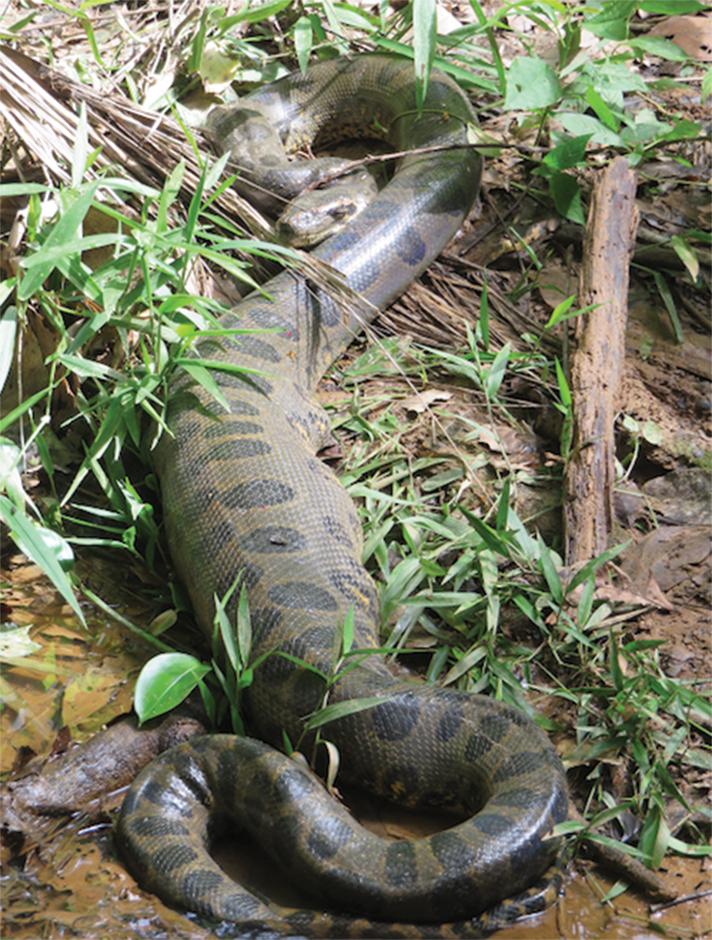
amanda sargent
A green anaconda, with its belly swollen. The researchers didn’t wish to disturb the reptile.
With only two days left of the expedition and just one anaconda under our belts (one we couldn’t even properly study due to her having a full stomach), it was obvious that the entire group was feeling the pressure. We trekked out to the swamps again and this time, instead of going in groups, we split up, because by now even those of us who were new to the jungle had seen and done enough to be able to fend for ourselves.
I was in the zone— even though I was sure it wouldn’t happen, I have to admit that I’d spent a lot of time visualizing what it would be like to find an anaconda on my own. I had that pattern burned into the front of my mind— those spots were there every time I blinked, and as my exhausted eyes scanned the swampy area at my feet, they suddenly, without warning, landed on something that made my heart stop. Immediately, I knew exactly what I had found, but it still took me at least 30 seconds of staring to process what was happening. There, jutting out of the water, was an olive green coil, stamped with unmistakable black dots. She barely refracted enough light to make her keratin scales glimmer, just a wink of iridescence to assure me that yes, I had just found exactly what I’d come here to find. It was a green anaconda.
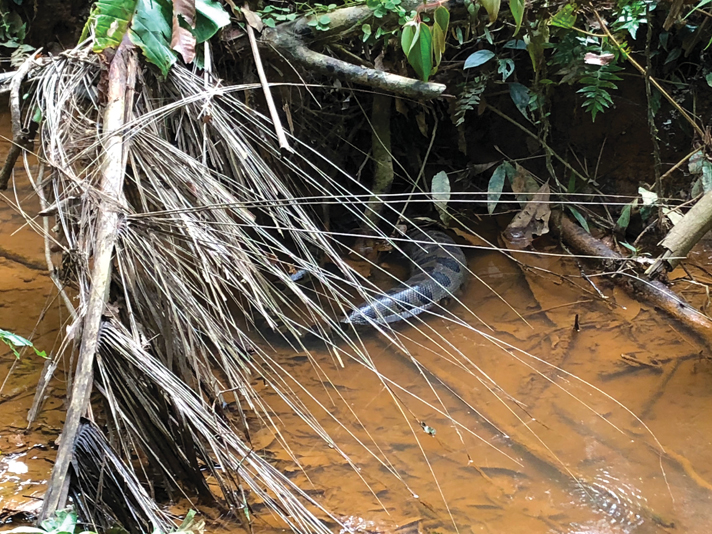
amanda sargent
A green anaconda in its element.

amanda sargent
The green anaconda the author found was about 7 feet in length.
“Anaconda,” I said. We’d been strictly prohibited from uttering that word unless we were sure we had eyes on an anaconda, and no one had been able to say it since we started. It felt weird. It was quiet at first, almost a question, so I said it again, because I was sure.
“Anaconda!” I yelled, and suddenly, everyone was lunging through the swamp in my direction.
“Anaconda!?”
“Yes, yes! I’ve got an anaconda!”
We grabbed the exposed coil and pulled out the rest of her, which had been buried in thick weeds. She turned out to be a juvenile, only 7 feet long, and she was not happy about being disturbed. She gave me her worst, striking at me and expelling everything she had all over me, so much I smelled like anaconda for days. I was okay with that. Just the fact that I’d found her was enough to make me the happiest person in the world. We brought her back to the research station to collect data on her, a confirmed female. If all goes well with her, she could easily grow to be a massive snake.
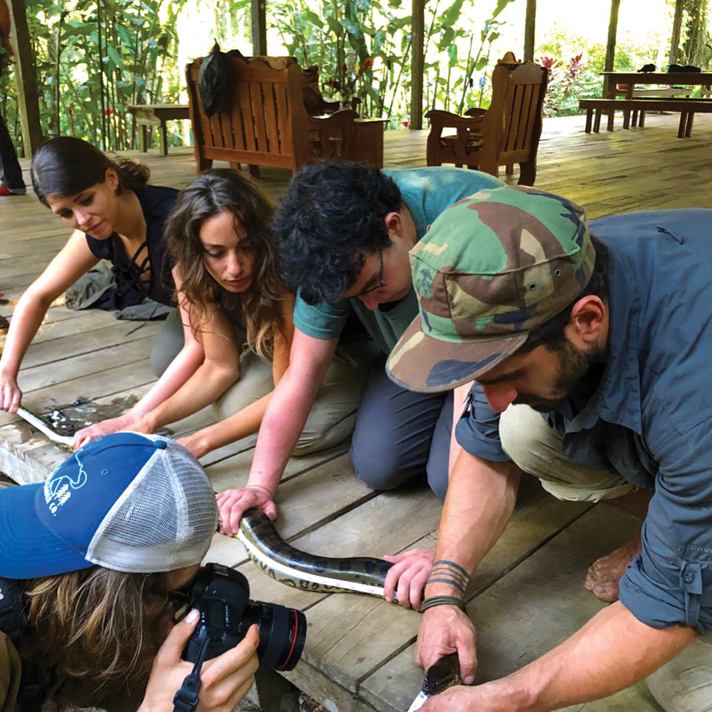
amanda sargent
Collecting data on the 7-foot green anaconda found by the author.
The Biodiversity of the Peruvian Amazon
Aside from the herps, the biodiversity of this incredible place is all around you. Anyone who loves animals and nature will be absolutely swept away by all of the wildlife. Troops of monkeys moving through the trees around you at any given moment. Toucans, macaws and hundreds of species of bats flying overhead. Stick insects and centipedes and tarantulas the size of dinner plates, and vibrant blue morpho butterflies fluttering past you when you least expect it, reminding you that you’ve entered a magical realm. I can’t imagine anyone could not resist the charm of seeing a family of capybara, a massive tapir or giant anteater, and if you’re lucky enough, maybe you’ll see one of the more secretive predators of the jungle. I consider myself lucky to have seen the green anaconda and harpy eagle, but hopefully next time I’ll be able to spot the elusive jaguar, the true king of the jungle.
When it comes to biodiversity, the Amazon is simply a treasure trove. One thing that makes all of that seem like a cherry on top was the honor of being able to participate in true, boots-on-the-ground conservation work alongside amazing, passionate conservationists. All of those days in the swamp when we found nothing trained my eyes and built my confidence enough to find an anaconda all on my own. It was far from a vacation, but well worth the grueling work and fear of those long days out in a vast, massive jungle, uncertain of every step you take.
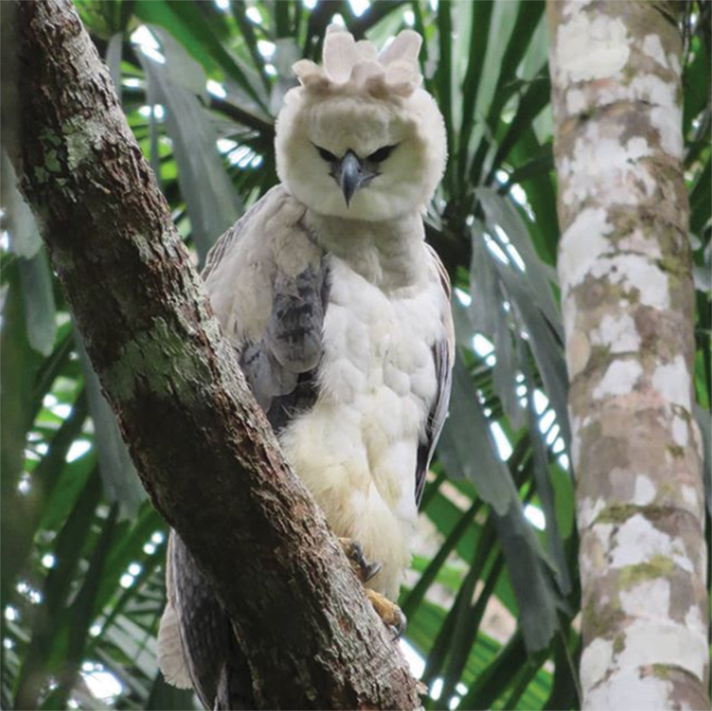
amanda sargent
The harpy eagle is the largest and most powerful raptor in the Amazon.
Being completely immersed in the Amazon rainforest is a feeling I’ll never forget. It’s both terrifying and empowering all at once. You’re aware of how incredibly small you are, and the fact that somehow you’re surviving and becoming a part of everything around you is a miracle. I’ve never felt more wild and connected to the Earth before. It’s like I grew brand new eyes out there—the ability to see nature for what it truly is. I can’t accurately describe it better than that and can instead only urge anyone who loves finding herps in the wild to see it one day, before it’s gone. In the meantime, I won’t ever stop fighting for the Amazon and for anacondas and the other magnificent animals they share their world with. While I was in Peru I saw lush, untouched jungle, but I also saw many barren fields where primary forest once stood, naked and stripped of life. The destruction of the Amazon is real, and it continues every single day. Ecotourism is one of the best ways we can support the conservation of the Amazon, to show those who seek to destroy it for its value that it’s worth more alive than dead. If you’ve ever dreamt of seeing it, now is the time.
Amanda Sargent is a wildlife conservationist from just outside Boston, MA who grew up exploring vernal ponds, catching snakes, and awaiting the annual spotted salamander migrations through her backyard. She now works as the Conservation Coordinator at the Amphibian Foundation, a non-profit conservation organization based in Atlanta, GA, dedicated to addressing the global amphibian crisis. Aside from field work and conservation husbandry, Amanda has a passion for harnessing the power of social media to educate the public about conservation through her Instagram (@theamandafiles) and a prolific group on Facebook called Everyday Conservation.

